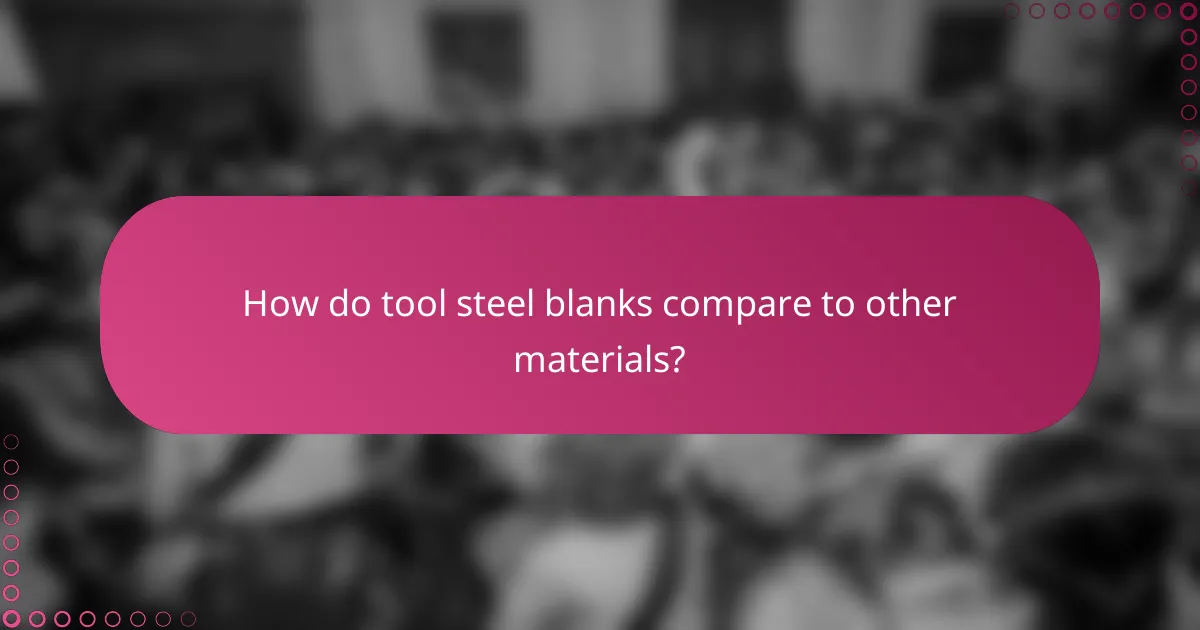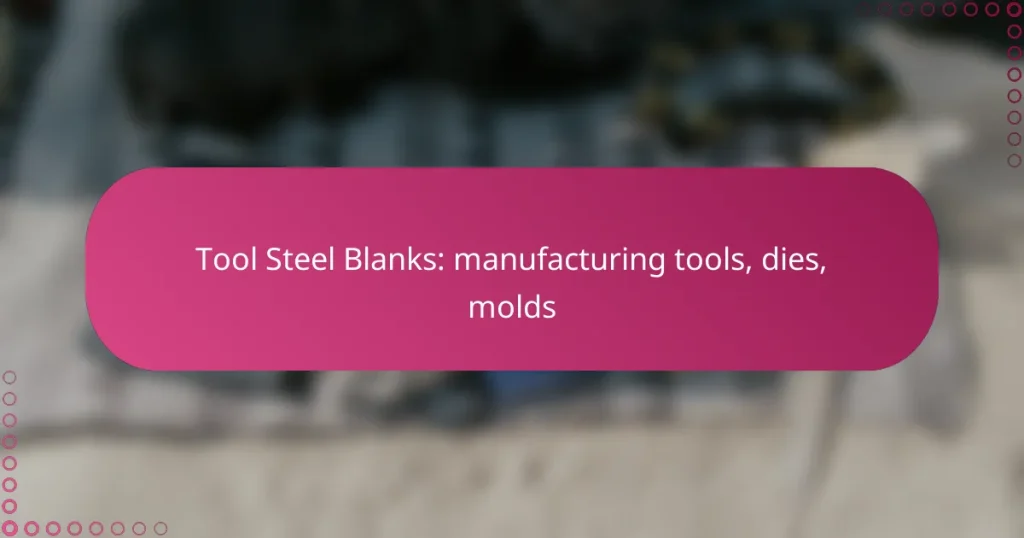Tool steel blanks are crucial for the production of high-performance tools, dies, and molds, known for their exceptional hardness and durability. Common grades such as AISI D2, AISI O1, and AISI M2 are preferred for their versatility and ability to withstand rigorous applications. Selecting the appropriate tool steel blank is essential, as it directly influences the effectiveness and lifespan of the manufactured components.

What are the best tool steel blanks for manufacturing tools in the USA?
The best tool steel blanks for manufacturing tools in the USA include AISI D2, AISI O1, and AISI M2. These grades are favored for their durability, hardness, and versatility in various applications, making them suitable for producing tools, dies, and molds.
AISI D2 Tool Steel Blanks
AISI D2 tool steel is known for its high wear resistance and toughness, making it ideal for cutting tools and dies. It typically contains around 1.5% carbon and 12% chromium, which contributes to its hardness and ability to retain a sharp edge.
When selecting D2 blanks, consider the heat treatment process, as proper hardening can significantly enhance performance. Common applications include stamping dies and shear blades, where durability is crucial.
AISI O1 Tool Steel Blanks
AISI O1 tool steel is a versatile oil-hardening steel that offers good machinability and edge retention. With a carbon content of about 0.9% and a balanced alloy composition, it is often used for making tools that require a sharp cutting edge.
This steel is particularly suitable for applications like drill bits and chisels. It is important to ensure proper heat treatment to achieve optimal hardness, typically in the range of 58-62 HRC.
AISI M2 Tool Steel Blanks
AISI M2 tool steel is a high-speed steel that excels in cutting applications due to its ability to withstand high temperatures without losing hardness. It contains around 0.9% carbon and significant amounts of tungsten and molybdenum, which enhance its performance under heat.
M2 is ideal for manufacturing tools like end mills and taps, where high wear resistance and toughness are necessary. Proper heat treatment can elevate its hardness to 62-65 HRC, making it a preferred choice in the manufacturing sector.

How to choose tool steel blanks for dies?
Choosing tool steel blanks for dies involves assessing the specific requirements of your application, including hardness, wear resistance, and heat treatment capabilities. Selecting the right material can significantly impact the performance and longevity of your dies.
Consider hardness and wear resistance
Hardness and wear resistance are critical factors when selecting tool steel blanks for dies. Tool steels are often rated on the Rockwell scale, with higher values indicating greater hardness. For most applications, a hardness range of 50-65 HRC is desirable, as it provides a balance between toughness and wear resistance.
Additionally, consider the specific wear resistance properties of the steel. For example, high-speed steels (HSS) and tool steels like D2 or A2 are known for excellent wear resistance, making them suitable for high-volume production environments. Evaluate the expected wear conditions to choose the most appropriate steel type.
Evaluate heat treatment capabilities
Heat treatment significantly influences the performance of tool steel blanks. Different grades of tool steel respond uniquely to heat treatment processes, affecting their hardness, toughness, and overall durability. Ensure the selected steel can achieve the desired hardness through quenching and tempering processes.
For instance, oil-hardening steels like O1 require specific heat treatment methods to reach optimal hardness levels. It is essential to consult the manufacturer’s specifications and guidelines to understand the heat treatment capabilities and limitations of the chosen steel blank.

What are the key specifications of tool steel blanks?
Tool steel blanks are essential components in manufacturing tools, dies, and molds, characterized by their specific dimensions, material composition, and mechanical properties. Understanding these specifications helps in selecting the right blank for various applications, ensuring durability and performance.
Thickness and dimensions
The thickness and dimensions of tool steel blanks vary widely depending on their intended use. Common thickness ranges from a few millimeters to several centimeters, while dimensions can extend to standard sizes like 100 mm x 200 mm or larger, depending on the application requirements.
When selecting a blank, consider the final product’s design and the machining processes involved. It’s crucial to choose dimensions that allow for adequate machining without excessive waste, as this can impact both cost and efficiency.
Material composition
Tool steel blanks are typically made from high-carbon and alloy steels, which provide superior hardness and wear resistance. Common compositions include D2, A2, and O1 tool steels, each offering different properties suited for specific applications, such as cutting or forming.
Understanding the material composition is vital for achieving the desired performance characteristics. For instance, D2 steel is known for its high wear resistance, making it ideal for cutting tools, while A2 offers good toughness and is often used in dies and molds.

What are the advantages of using tool steel blanks for molds?
Tool steel blanks offer significant advantages for molds, including enhanced durability and improved surface finish. These benefits stem from the material’s inherent properties, making it ideal for high-performance applications in manufacturing.
Enhanced durability
Tool steel blanks are known for their exceptional durability, which is crucial for molds that undergo repeated use. The high hardness and wear resistance of tool steel help maintain the integrity of the mold over time, reducing the frequency of replacements.
When selecting tool steel for molds, consider grades such as D2 or A2, which provide excellent toughness and resistance to deformation. This durability translates into lower operational costs, as fewer replacements are needed, and production downtime is minimized.
Improved surface finish
Using tool steel blanks can lead to a superior surface finish on molded products. The fine grain structure of tool steel allows for smoother surfaces, which is essential for achieving high-quality finishes in final products.
To maximize surface quality, ensure proper machining and polishing techniques are employed. This attention to detail can significantly enhance the aesthetic and functional properties of the molded items, making them more appealing in competitive markets.

What are the common applications of tool steel blanks?
Tool steel blanks are primarily used in the manufacturing of various industrial components such as molds, dies, and cutting tools. Their high hardness and resistance to wear make them ideal for applications requiring durability and precision.
Injection molds
Injection molds are essential in the production of plastic parts, where molten plastic is injected into a mold cavity to form a specific shape. Tool steel blanks are favored for these molds due to their ability to withstand high temperatures and pressures during the injection process.
When selecting tool steel for injection molds, consider factors such as thermal conductivity and corrosion resistance. Common choices include P20 and H13 steels, which offer a good balance of toughness and hardness. Regular maintenance and proper cooling systems can significantly extend the lifespan of these molds.
Stamping dies
Stamping dies are used to shape and cut materials, typically metals, into desired forms through a stamping process. Tool steel blanks are crucial in this application as they provide the necessary hardness to endure repeated impacts and maintain dimensional accuracy.
For stamping dies, materials like D2 and A2 tool steels are often utilized due to their excellent wear resistance and ability to retain sharp edges. It is important to ensure proper heat treatment to achieve optimal hardness and toughness, as this can greatly affect the performance and longevity of the dies.

How do tool steel blanks compare to other materials?
Tool steel blanks are known for their durability and strength, making them a preferred choice for manufacturing tools, dies, and molds. Compared to other materials like aluminum and plastic, tool steel offers superior hardness and wear resistance, which are critical for high-performance applications.
Versus aluminum
When comparing tool steel blanks to aluminum, the key difference lies in strength and thermal stability. Tool steel is significantly harder and can withstand higher temperatures without deforming, making it ideal for heavy-duty applications. Aluminum, while lighter and easier to machine, lacks the same level of durability and is more prone to wear under stress.
In practical terms, tool steel is often used for precision tools and dies that require long-lasting performance, whereas aluminum may be chosen for lighter, less demanding applications. For example, a tool steel die can last several times longer than an aluminum counterpart in high-volume production settings.
Versus plastic
Tool steel blanks outperform plastic in terms of strength, heat resistance, and longevity. While plastics are lightweight and can be molded into complex shapes easily, they generally cannot handle the same levels of stress and temperature as tool steel. This makes tool steel the better choice for applications that involve high pressure or friction.
For instance, in injection molding, tool steel molds can produce thousands of parts with consistent quality, whereas plastic molds may wear out quickly and require frequent replacement. Choosing tool steel for critical applications ensures reliability and reduces downtime due to mold failure.

What are the manufacturing processes for tool steel blanks?
The manufacturing processes for tool steel blanks typically involve forging and machining. These methods are essential for shaping the steel into the desired forms needed for tools, dies, and molds.
Forging
Forging is a process where tool steel is shaped by applying compressive forces, often using hammers or presses. This method enhances the material’s strength and durability by aligning the grain structure of the steel. Common forging techniques include open-die forging and closed-die forging, each offering different benefits in terms of precision and material usage.
When selecting forging, consider the size and complexity of the blank. Open-die forging is suitable for larger, simpler shapes, while closed-die forging is better for intricate designs. The choice can impact production costs and lead times, so weigh these factors carefully.
Machining
Machining involves removing material from a tool steel blank to achieve precise dimensions and surface finishes. This process can include techniques such as milling, turning, and grinding. Machining is often necessary after forging to meet tight tolerances required for high-performance tools.
During machining, it’s crucial to select the right tools and cutting parameters to avoid overheating and tool wear. For example, using coolant can help maintain temperature and prolong tool life. Additionally, consider the type of machining operation based on the complexity of the part, as some methods may be more efficient than others for specific geometries.

What factors influence the pricing of tool steel blanks?
The pricing of tool steel blanks is influenced by several key factors, including material grade, manufacturing processes, and market demand. Understanding these elements can help buyers make informed decisions and optimize their purchasing strategies.
Material grade
The material grade of tool steel blanks significantly impacts their price. Higher-grade materials, such as D2 or M2, typically cost more due to their superior properties, including hardness, wear resistance, and toughness. In contrast, lower-grade options may be more affordable but could compromise performance in demanding applications.
When selecting a material grade, consider the specific requirements of your project. For instance, if you need a blank for high-volume production, investing in a premium grade may yield better long-term value despite the higher upfront cost. Conversely, for less critical applications, a standard grade might suffice.


